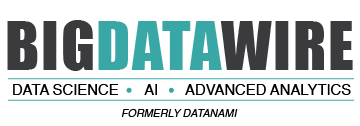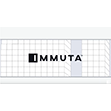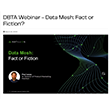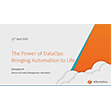
ChatGPT Gives Kinetica a Natural Language Interface for Speedy Analytics Database

(SuPatMaN/Shutterstock)
It would normally take quite a bit of complex SQL to tease a multi-pronged answer out of Kinetica’s high-speed analytics database, which is powered by GPUs but wire-compataible with Postgres. But with the new natural language interface to ChatGPT unveiled today, non-technical users can get answers to complex questions written in plain English.
Kinetica was incubated by the U.S. Army over a decade ago to pour through huge mounds of fast-moving geospatial and temporal data in search of terrorist activity. By leveraging the processing capability of GPUs, the vector database could run full table scans on the data, whereas other databases were forced to winnow down the data with indexes and other techniques (it has since embraced CPUs with Intel’s AVX-512).
With today’s launch of its new Conversational Query feature, Kinetica’s massive processing capability is now within the reach of workers who lack the ability to write complex SQL queries. That democratization of access means executives and others with ad-hoc data questions are now able to leverage the power of Kinetica’s database to get answers.
The vast majority of database queries are planned, which enables organizations to write indexes, de-normalize the data, or pre-compute aggregates to get those queries to run in a performant way, says Kinetica co-founder and CEO Nima Negahban.
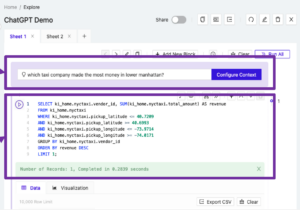
A user can submit a natural langauge query directly on the Kinetica dashboard, which ChatGPT converts to SQL for execution
“With the advent of generative large language models, we think that that mix is going to change to where a lot bigger portion of it’s going be ad hoc queries,” Negahban tells Datanami. “That’s really what we do best, is do that ad hoc, complex query against large datasets, because we have that ability to do large scans and leverage many-core compute devices better than other databases.”
Conversational Query works by converting a user’s natural language query into SQL. That SQL conversion is handled by OpenAI’s ChatGPT large language model (LLM), which proven itself to be a quick learner of language–spoken, computer, and otherwise. OpenAI API then returns the finalized SQL, and users can then choose to execute it against the database directly from the Kinetica dashboard.
Kinetica is leaning on the ChatGPT model to understand the intent of language, which is something that it’s very good at. For example, to answer the question “Where do people hang out the most?” from a massive database of geospatial data of human movement, ChatGPT is smart enough to know that “hang out” is a synonym for “dwell time,” which is how the data is officially identified in the database. (The answer, by the way, is 7-Eleven.)
Kinetica is also doing some work ahead of time to prepare ChatGPT to generate good SQL through its “hydration” process, says Chad Meley, Kinetica’s chief marketing officer.
“We have native analytic functions that are callable through SQL and ChatGPT, through part of the hydration process, becomes aware of that,” Meley says. “So it can use a specific time-series join or spatial join that we make ChatGPT aware of. In that way, we go beyond your typical ANSI SQL functions.”
The SQL generated by ChatGPT isn’t perfect. As many are aware, the LLM is prone to seeing things in the data, the so-called “hallucination” problem. But even though it’s SQL isn’t completely free of defect, ChatGPT is still quite useful at this state, says Negahban, who was a 2018 Datanami Person to Watch.
“I’ve seen that it’s kind of good enough,” he says. “It hasn’t been [wildly] wrong in any queries it generates…I think it will be better with GPT-4.”
In the end analysis, by the time it takes a SQL pro to write the perfect seven-way join and get it over to the database, the opportunity to act on the data may be gone. That’s why the pairing of a “good enough” query generator with a database as powerful as Kinetica can make a different for decision-makers, Negahban says.
“Having an engine like Kinetica that can actually do something with that query without having to do planning beforehand” is the big get, he says. “If you try to do some of these queries with the Snowflake, or insert your database du jour, they really struggle because that’s just not what they’re built for. They’re good at other things. What we’re really good at, as an engine, is to do ad hoc queries no matter the complexity, no matter how many tables are involved. So that really pairs well with this ability for anyone to generate SQL across all their data asking questions about all the data in their enterprise.”
Conversational Query is available now in the cloud and on-prem versions of Kinetica.
Related Items:
ChatGPT Dominates as Top In-Demand Workplace Skill: Udemy Report
Bank Replaces Hundreds of Spark Streaming Nodes with Kinetica
Preventing the Next 9/11 Goal of NORAD’s New Streaming Data Warehouse
February 20, 2025
- Accenture Invests in Voltron Data to Help Organizations Use GPU Tech to Simplify Large-Scale Data Processing
- DDN Unveils Infinia 2.0 to Streamline AI Data Management and GPU Utilization
- Together AI Raises $305M Series B to Power AI Model Training and Inference
- Starburst Closes Record FY25, Fueled by Rising AI Demand and Growing Enterprise Momentum
- GridGain Brings Apache Ignite Community Together for Ignite Summit 2025
- Elasticsearch Open Inference API now Supports Jina AI Embeddings and Rerank Model
- HarperDB Named an IDC Innovator for Edge Inference Delivery
- EDB Postgres AI Outperforms Oracle, SQL Server, and MongoDB in New Benchmark
- CData and Ellie.ai Partner to Streamline Enterprise Data Modeling
- Privacera Aligns AI Governance with NIST Standards to Mitigate AI Risks
February 19, 2025
- AtScale and Snowflake Announce Integration with Cortex Analyst to Deliver Trustworthy Natural Language Queries
- Sawmills Exits Stealth with $10M to Tackle Skyrocketing Observability Costs Using AI
- Prophecy Finds GenAI Boosting Data Team Productivity by Up to 50%
- CTERA Enhances Cybersecurity and AI Capabilities in Record-Setting Year
- VAST Data Introduces Event Broker for AI-Driven Real-Time Streaming
- DiffusionData Announces Free Trial of Diffusion Cloud
- Cube Launches Cube Cloud for the Microsoft Enterprise
- VAST Data Adds Block Storage to Unify Enterprise AI and Hybrid Workloads
February 18, 2025
- OpenTelemetry Is Too Complicated, VictoriaMetrics Says
- What Are Reasoning Models and Why You Should Care
- Three Ways Data Products Empower Internal Users
- Keeping Data Private and Secure with Agentic AI
- Memgraph Bolsters AI Development with GraphRAG Support
- Three Data Challenges Leaders Need To Overcome to Successfully Implement AI
- PayPal Feeds the DL Beast with Huge Vault of Fraud Data
- Top-Down or Bottom-Up Data Model Design: Which is Best?
- What Leonardo DaVinci Teaches Us About Data Management
- Inside Nvidia’s New Desktop AI Box, ‘Project DIGITS’
- More Features…
- Meet MATA, an AI Research Assistant for Scientific Data
- AI Agent Claims 80% Reduction in Time to Complete Data Tasks
- DataRobot Expands AI Capabilities with Agnostiq Acquisition
- Snowflake Unleashes AI Agents to Unlock Enterprise Data
- EDB Says It Tops Oracle, Other Databases in Benchmarks
- Collibra Bolsters Position in Fast-Moving AI Governance Field
- Microsoft Open Sources Code Behind PostgreSQL-Based MongoDB Clone
- AI Making Data Analyst Job More Strategic, Alteryx Says
- VAST Data Expands Platform With Block Storage And Real-Time Event Streaming
- Databricks Unveils LakeFlow: A Unified and Intelligent Tool for Data Engineering
- More News In Brief…
- Informatica Reveals Surge in GenAI Investments as Nearly All Data Leaders Race Ahead
- Gartner Predicts 40% of Generative AI Solutions Will Be Multimodal By 2027
- PEAK:AIO Powers AI Data for University of Strathclyde’s MediForge Hub
- DataRobot Acquires Agnostiq to Accelerate Agentic AI Application Development
- Cloudera Welcomes Tom Brady as Keynote Speaker at ELEVATE26
- TigerGraph Launches Savanna Cloud Platform to Scale Graph Analytics for AI
- EY and Microsoft Unveil AI Skills Passport to Bridge Workforce AI Training Gap
- Alluxio Enhances Enterprise AI with Version 3.5 for Faster Model Training
- DeepSeek-R1 models now available on AWS
- Lightning AI Brings DeepSeek to Private Enterprise Clouds with AI Hub
- More This Just In…
